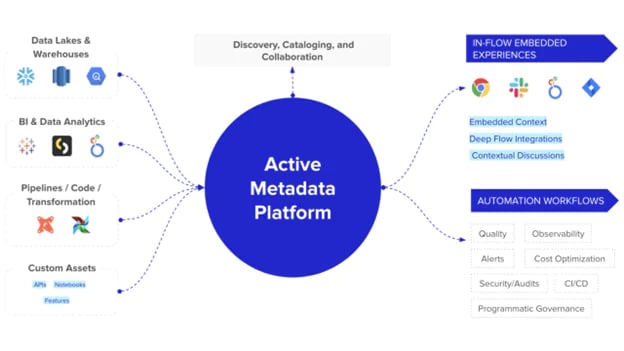In our previous article on metadata, we explored what it actually is and how you could use it to add value to your organisation’s activities. This is the foundation of why metadata management is so important, and why many organizations have introduced a repository to centrally manage their metadata. In recent years, the data profession has moved on from a metadata management platform being a passive repository, to provide more to the consumers (system or end users) of its content.
In this article we will explore metadata management capabilities and this shift from passive to active metadata management.
Metadata management activities
Before we discuss the market shift it’s worth taking a step back and defining what we mean by the “management” of metadata. We’ve defined in our last article what meta data is and how it can be used but what activity needs to occur in organizations’ looking to manage this type of data?
Meta data management should consist of several activities:
- linking metadata initiatives to clear business outcomes (e.g .discoverability, dissemination)
- establishing an effective accountability and responsibility model (ownership vs stewardship)
- using metadata tooling to automate and accelerate the creation of metadata (integration and business rules)
- defining and applying data standards (principles, policies, regulation)
- building an on- going repeatable operating model for the management of metadata management (metadata lifecycle management)
As the capacity of organizations to collect and store data increases, the role of Metadata in data management grows in importance. To be data-driven, an organization must be Metadata-driven.
Market shift
In 2021 Gartner replaced the magic quadrant for metadata management with ‘the market guide for active metadata management’.
“Active metadata management is a set of capabilities that enable continuous access and processing of metadata that support ongoing analysis…”
Gartner 2021
By doing so, they implied that metadata ownership transfers from the CIO to the chief data officer (CDO) making the distinction that data is not the preserve of IT but a data asset to be managed and leveraged for business benefit. Therefore, as data is now owned and managed by accountable and responsible business users, the need for a usable and accessible metadata solution becomes paramount. Crucially, these solutions need to be more geared toward user experience and collaboration than ever before.
Whereas traditional data catalogues collect metadata and bring it into a “passive” tool, active metadata platforms act as two-way collaboration platforms. They not only bring metadata together into a single store, but also leverage “reverse metadata” to make metadata available for operational processes.
Active versus passive.
Active metadata is built on the premise of actively finding, enriching, inventorying, and using all of this metadata, taking a traditionally “passive” technology and making it truly action oriented. The cornerstone of any active metadata platform, the metadata lake, is a unified repository to store all kinds of metadata, in raw and further processed forms, which can be used to drive both the use cases we know of today and those of tomorrow. The metadata lake is accessed and consumed by Open APIs and interfaces.

Sourcing Recommendations for active metadata tools
So if you are thinking about making an investment into metadata management solutions then our advice would be to look for the following critical capabilities:
- Ensure candidate systems can share metadata by identifying tools and platforms that can export their own metadata and in turn can import metadata to run to processing instructions.
- The ability to share internal metadata to support broader platform-to-platform orchestration, and integration with BI (business Intelligence) tooling.
- The ability to accept parameterized instructions to alter design inputs such as job flow, resource allocation, and manage dependent calls to third-party tools.
- Enable support for automated system changes in adjacent data management systems with tools that support metadata workflow management capabilities, including collaborative design capabilities
Additionally other common capabilities we have seen our clients explore are collaboration and workflows, common language / vocabulary, connectivity, data Lineage, ownership and compliance, security and user experience.
The need for Active metadata management
We welcome the shift to active metadata management as the value of meta data is in its ability to be change and evolve, something that is acted on and valuable, and that is reflected our experience of helping clients build up their metadata management capabilities – successful implementations are those where collaboration, learning and availability of metadata are prioritised.
Metadata management has become a critical functionality in all data-enabling technologies and metadata analytics, augmented and automated design will become the critical foundation of data management platforms.
Peru Consulting are award winning IT management consultants helping turn your digital strategy to reality, we specialise in providing advisory and delivery services in data, cloud, architecture, operating models, sourcing and supplier management. Our 700+ years of collective experience provides unrivalled knowledge for our clients to leverage and embed into their teams.
Contact Us today to discuss your metadata requirements and how these can be actively managed



